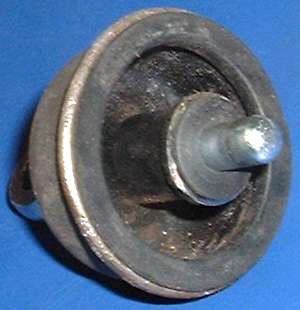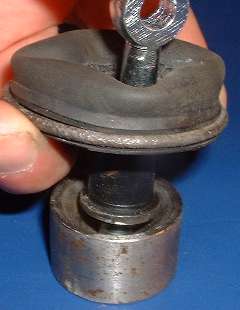The MGA With An Attitude
CLUTCH SLAVE CYLINDER PARTS - HT-107
At 03:53 PM 4/15/04 -0700, Howard Battan wrote:
>".... '57 MGA .... rebuilding the clutch slave cylinder .... one part missing .... called "clip for boot, small. .... Is its purpose to provide a leak-proof fit of the boot around the pushrod?"

The part in question is the small ring in the center of the picture
Not exactly leak proof. If the piston seal leaks, the outer boot will never retain the fluid. But the small ring on the boot can help to keep dirt and water out of the cylinder, and therefore delay or retard corrosion of the bore. This is not so important when the boot is new, but with exposure to oil they don't stay "new" very long. The boot is more likely to allow trash inside as it ages, and then the inside clip can help. The alternative is to put replacement of the boot on your periodic maintenance schedule, every couple of years or so (if you drive it much).
>"How important is it to find a replacement?"
It is worth the effort, and not too much bother. Be nice to the car and install the small steel ring. This may save the cost of a replacement slave cylinder some years later. Install the ring on the boot first, then slip the boot onto the pushrod, with about 1/2 inch of the rod end exposed. The ring should be an interference fit to squeeze the neck of the boot securely on the pushrod.
 
If you don't have the original "small ring, you can make one from an appropriate flat washer. Optimal dimensions would be 3/32" thickness, 0.595-0.610" ID, and 3/4 to 7/8" OD (although up to 1" OD may work). A close starting part would be ANSI Type A Plain Washer Narrow series. This is .594 ID, 1.156" OD, 0.095" Thickness. This could be a good fit on ID and thickness, but I would recommend grinding down the OD. Alternately you could start with a smaller washer and drill out the ID to suit. The thickness always needs to be close to 3/32". Keep the OD of the washer small enough so it doesn't interfere with the tapered socket in the piston. In particular, it should fit completely inside of the piston.
>"Since I have been driving since 1975 without one, I assume it is not critical!"
If you would like to be able to rebuild that aluminum slave cylinder about 10 years later, and not have to buy a new one, then it is critical. Without the inner clip the thing is likely to allow water infiltration several years down the road, when you splash through a rain puddle. Once inside, the water may remain in liquid form for a long time, and the resulting corrosion of the aluminum bore can be severe. If the bore is badly pitted it would have to be sleeved or replaced. If you can keep it free of corrosion, then next time around you may be able to hone it a little and install new rubber bits to save the cost of a new part.
Barney Gaylord
1958 MGA with an attitude
(and the same slave cylinder since 1986, already honed and rebuilt once)
|


